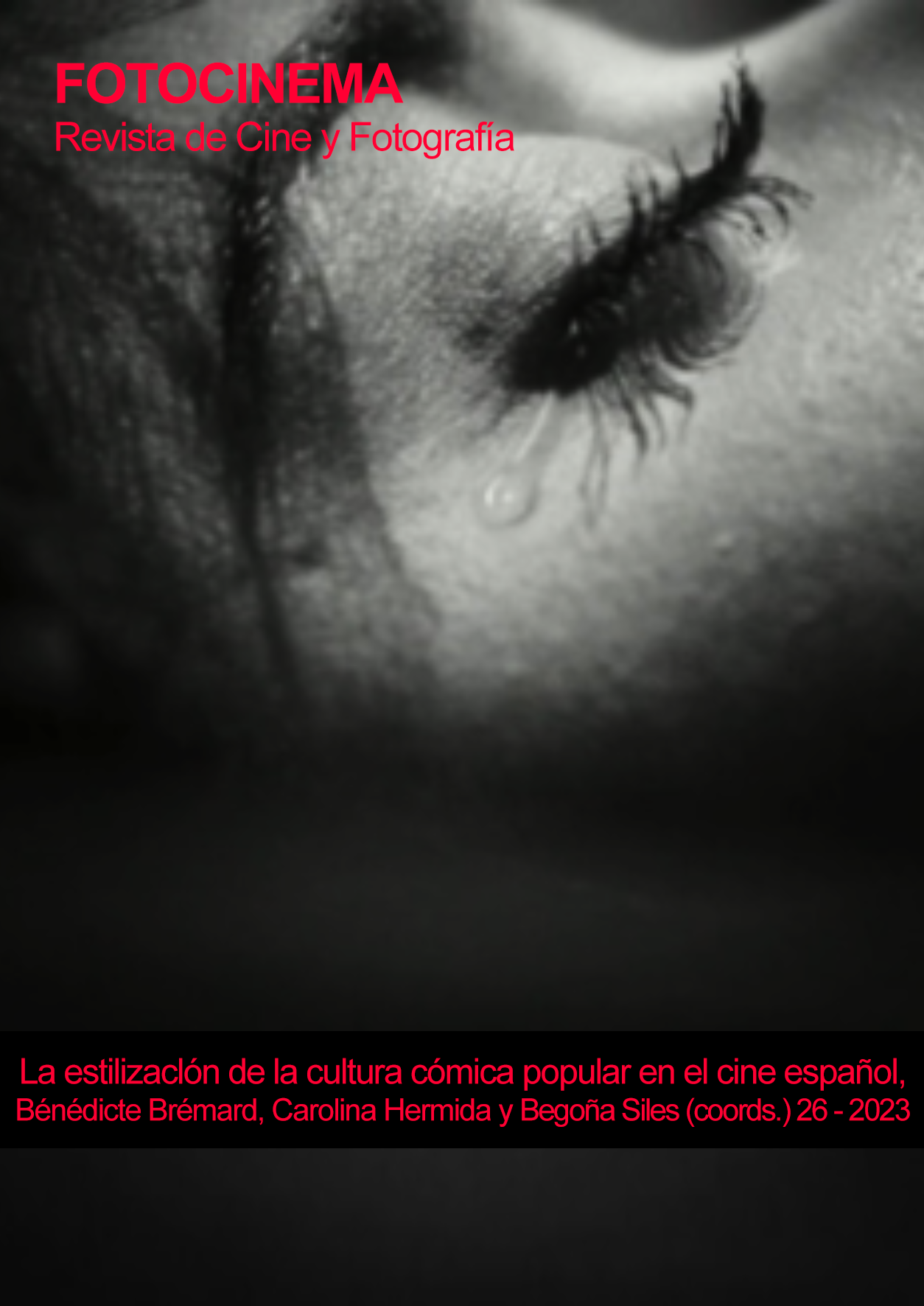Death of the Cinema, long life of the Audiovisual?
DOI:
https://doi.org/10.24310/Fotocinema.2023.vi26.15568Keywords:
Aesthetics, Theory of Cinema, Digital Cinema, Exhibition, CinephiliaAbstract
The generalization of digitization in the cinematographic field has changed not only the form of our access to the cinema but also our relationship with it, its social and cultural significance and the habits in which we consume it. The changes are so strong, radical and permanent that they imply a transformation in itself of the cinematographic fact, in such a way that we can ask ourselves, today more than ever, if we can really continue using the concept of “cinema” in the same way that we have used it all over the world the history of cinema, throughout the 20th century and until the widespread implantation of the so-called digital age. And if it’s not really the same art anymore (or the same industry), how should we refer to it? How can we re-think its meaning, its consumption, its social, cultural and artistic sphere? How is our relationship with this new digital medium? Is there anything salvageable from the old consensus about cinema and its spectator act? About its consumption and its industrial organization?Downloads
Metrics
Publication Facts
Reviewer profiles N/A
Author statements
Indexed in
-
—
- Academic society
- N/A
- Publisher
- Universidad de Málaga
References
Baecque, Antoine de (2005). Teoría y crítica del cine. Avatares de una cinefilia. Barcelona: Paidós.
Gubern, Román (2012). Cultura Audiovisual. Escritos 1981-2011. Madrid: Cátedra.
Gubern, Román (1995a). “Cien años de cine” en Manuel Palacio y Santos Zunzunegui (Eds.) Historia General del Cine. Volumen XII El cine en la era del audiovisual. Madrid: Cátedra, colección: Signo e imagen, páginas: 261-287.
Gubern, Román (1995b). “El cine después del cine” en Manuel Palacio y Santos Zunzunegui (Eds.) Historia General del Cine. Volumen XII El cine en la era del audiovisual. Madrid: Cátedra, colección: Signo e imagen, páginas: 289-309.
Isaacs, Bruce (2008). Toward a New Film Aesthetic. Londres y Nueva York: The Continuum International Publishing Group.
Isaacs, Bruce (2013). The Orientation of Future Cinema. Technology, Aesthetics, Spectacle. Londres y Nueva York: Bloomsbury.
Kwastek, Katja (2015). Aesthetics of Interaction in Digital Art. Cambridge (USA) y Londres: The MIT Press.
Lipovetsky, Gilles & Serroy, Jean (2009). La pantalla global. Cultura mediática y cine en la era hipermoderna. Barcelona: Anagrama.
Losilla, Carlos (2004). “Prólogo: una cuestión de fe” en en Baecque, Antoine de y Tesson, Charles (Comp.): (2004): Una cinefilia a contracorriente. La Nouvelle Vague y el gusto por el cine americano. Barcelona: Paidós, páginas: 28-29.
Márquez, Israel (2015). Una genealogía de la pantalla. Del cine al teléfono móvil. Barcelona: Anagrama.
McGinn, Collin (2005). The Power of Movies. How Screen and Mind Interact. Nueva York: Pantheon Books.
Ministerio de Cultura (2010). Informe sobre el audiovisual en: http://www.mcu.es/cine/docs/MC/BIC/2010/01.Introduccion_Graficos_Evolucion.pdf
Ministerio de Cultura y Deporte (2022). Encuesta de hábitos y prácticas culturales 2021-2022: https://www.culturaydeporte.gob.es/dam/jcr:f2932131-e501-4da6-b5f4-6387044916cf/encuesta-de-habitos-y-practicas-culturales-2021-2022.pdf
Portabella, Pere (2010). “Prólogo” en ROSENBAUM, Jonathan & MARTIN, Adrian (Coord.): Mutaciones del cine contemporáneo. Madrid: Errata naturae editores, páginas: 7-22.
Quintana, Àngel (2011). Después del cine. Imagen y realidad en la era digital. Barcelona: Acantilado.
Rodowick, D. N. (2007). The Virtual Life of Film. Cambridge (USA) y Londres: Harvard University Press.
Rodowick, D. N. (2013). “Una brújula para un mundo en movimiento (sobre los géneros y las genealogías de la teoría)” en Eu-topopías. Revista de interculturalidad, comunicación y estudios europeos, Volumen 6, otoño, páginas: 37-50.
Rodowick, D. N. (2014). Elegy for Theory. Cambridge (USA) y Londres: Harvard University Press.
Rosenbaum, Jonathan & Martin, Adrian (Coord.) (2010). Mutaciones del cine contemporáneo. Madrid: Errata naturae editores.
Ruiz Jiménez, Antonio Gabriel (2005). El cine: ¿muerte o transfiguración? La disolución del lenguaje cinematográfico en el universo audiovisual. Sevilla: Comunicación Social Ediciones y Publicaciones.
Sontag, Susan (1996). “The Decay of Cinema” en The New York Times, 25 de febrero; recuperado de https://www.nytimes.com/1996/02/25/magazine/the-decay-of-cinema.html (consultado el 4 de octubre de 2022).
Usai, Paolo Cherchi (2005). La muerte del cine. Historia y memoria cultural en el medioevo digital. Barcelona: Laertes.
Zurian, Francisco A. (2011): Pensar el cine. Madrid: Ocho y medio libros de cine.
Downloads
Published
How to Cite
Issue
Section
License
All contents published in Fotocinema Revista científica de cine y fotografía are protected under the Creative Commons Attribution-NonCommercial-ShareAlike 4.0 International (CC BY-NC-SA 4.0) license. All about this license is available in the following link: <http://creativecommons.org/licenses/by-nc-sa/4.0>
Users can copy, use, redistribute, share and exhibit publicly as long as:
- The original source and authorship of the material are cited (Journal, Publisher and URL of the work).
- It is not used for comercial purposes.
- The existence of the license and its especifications are mentioned.
There are two sets of authors’ rights: moral and property rights. Moral rights are perpetual prerogatives, unrenounceable, not-transferable, unalienable, imprescriptible and inembargable. According to authors’ rights legislation, Fotocinema. Revista científica de cine y fotografía recognizes and respects authors moral rights, as well as the ownership of property rights, which will be transferred to University of Malaga in open access. The property rights are referred to the benefits that are gained by the use or the dissemination of works. Fotocinema. Revista científica de cine y fotografía is published in an open access form and it is exclusively licenced by any means for doing or authorising distribution, dissemination, reproduction, , adaptation, translation or arrangement of works.
Authors are responsable for obtaining the necessary permission to use copyrighted images.














13.png)



